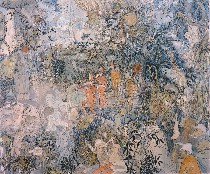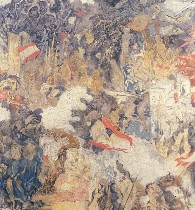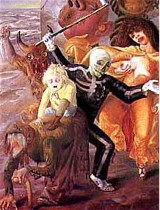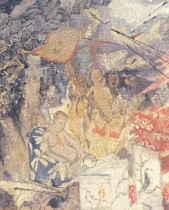
Walking down the street this morning, it suddenly struck me how appropriate the pairing is between “Yun-Fei Ji: The East Wind” show and the “Big Nothing” exhibit at the ICA.
Ji, now a resident of Brooklyn, still keeps a foot in China in both technique and subject matter. His paintings use traditional Chinese methods and materials as well as Chinese history (top, “Dinner at the Forbidden City”).
Even without this knowledge, though, a Westerner lacking Chinese historical background and familiarity with the techniques can find ways into this work, which suggests a world dripping in decadence and distorted values, a topsy-turvy land of confusion and injustices.
 But what makes the two worlds at the ICA a nice fit are Ji’s blotted out areas, reminders of how people who fell out of favor in China got erased from propaganda paintings–or how people who were something became big nothings, and how historical fact just disappeared (shown, “The Forbidden City Ghosts”).
But what makes the two worlds at the ICA a nice fit are Ji’s blotted out areas, reminders of how people who fell out of favor in China got erased from propaganda paintings–or how people who were something became big nothings, and how historical fact just disappeared (shown, “The Forbidden City Ghosts”).I agree with Roberta’s post about Ji’s work, where she suggests a relationship between this work and German Expressionism (below right, Otto Dix’s “Seven Deadly Sins”), the distorted cartoons of people and people-as-monsters cavorting while the culture went to hell in a handbasket. I see this as a commentary on our own culture as well.
 The work is agitated and frought with anger, frustration and astonishment.
The work is agitated and frought with anger, frustration and astonishment.
The good news is that if you are historically impaired vis a vis the relevant Chinese history, the ICA has provided a couple of DVDs in which Dr. Yangwen Zheng, a historian at the University of Pennsylvania, talks about the Boxer Rebellion, and about the Opium War, which she says marks the beginning of modern China. (I was also grateful for the bench, a place to rest while listening.) Her Cliff notes to the panoramic “Uprising of the Boxers” were quite helpful.
 Unlike the usual acoustiguide experiences, with their lowest-common-denominator explanations, Zheng’s talks were scholarly and informative. The DVDs also contain a couple of excellent talks by Ji, himself–all of which helped pull me into the work, which for all its accessible iconography (the decadence, the cartooniness, the storytelling) is still quite obscure if you don’t know who’s who or are unfamiliar with the traditional symbols of Chinese painting (left, “The Forbidden City Ghosts” detail).
Unlike the usual acoustiguide experiences, with their lowest-common-denominator explanations, Zheng’s talks were scholarly and informative. The DVDs also contain a couple of excellent talks by Ji, himself–all of which helped pull me into the work, which for all its accessible iconography (the decadence, the cartooniness, the storytelling) is still quite obscure if you don’t know who’s who or are unfamiliar with the traditional symbols of Chinese painting (left, “The Forbidden City Ghosts” detail).









